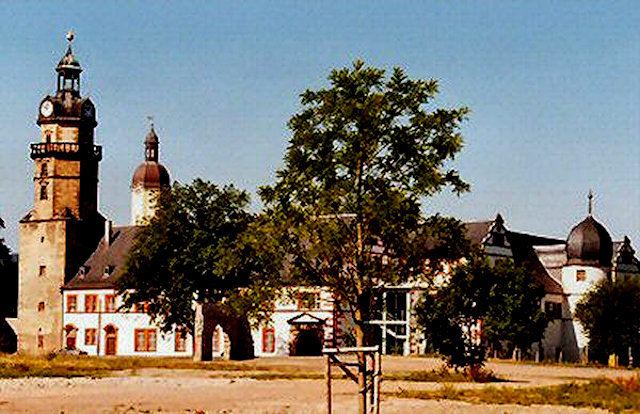Time zone CET/CEST (UTC+1/+2) Local time Thursday 8:28 AM | Elevation 375 m (1,230 ft) Postal codes 99885 Population 5,824 (31 Dec 2008) | |
 | ||
Weather 6°C, Wind E at 6 km/h, 99% Humidity Points of interest Tobiashammer, Museum im Schloss Ehrenstein, Haus Mühlberg | ||
Ohrdruf is a small town in the district of Gotha in the German state of Thuringia. It lies some 30 km southwest of Erfurt at the foot of the northern slope of the Thuringian Forest.
Contents
- Map of Ohrdruf Germany
- Medieval and early modern
- 19th century
- World wars
- Post World War II
- Sights
- References
Map of Ohrdruf, Germany
Medieval and early modern
Ohrdruf was reportedly founded in 724–726 by Saint Boniface, as the site of the first monastery in Thuringia, dedicated to Saint Michael. It was the first of several religious foundations in the town, the latest of which is the Carmelite monastery Karmel St. Elija (founded 1991).
In 1550, under Georg II von Gleichen work began on Schloss Ehrenstein at the site of the former 8th century monastery.
During the 17th century, the Schloss fell to the Grafen von Hohenlohe who after 1760 made alterations to it in Baroque style.
In 1695, the orphaned Johann Sebastian Bach came to live and attend school at Ohrdruf, under the care of his older brother Johann Christoph Bach (1671–1721), who had come here in 1690 as organist at the St. Michaelis Kirche (St Michael's Church) and as a teacher at the Lyceum. Johann Sebastian lived in Ohrdruf from the ages of 10 to 15.
19th century
In the 19th century, the town became a centre of toy manufacturing. The Kewpie doll was produced here from 1913. There are still some old molds embedded in the facades of Ohrdruf buildings.
In 1869, the Hohenlohe family sold the Grafschaft Gleichen including the castle and town of Ohrdruf to the Duchy of Saxe-Gotha.
World wars
The nearby Truppenübungsplatz Ohrdruf (military training area) served as a POW camp during World War I, housing around 20,000 prisoners. It was later used by the Wehrmacht and in the fall of 1944 a section of it became the Ohrdruf concentration camp. The prisoners were used to construct roads, railways and subterranean tunnels. The latter were to include a temporary headquarters for the Nazi leadership following the evacuation of Berlin (Führerhauptquartier).
According to German historian Rainer Karlsch, the facility built at nearby Jonastal was one of two locations where the Nazi Diebner's team has tested its nuclear energy project. During this process, according to Karlsch, prisoners of war were killed under the supervision of the SS.
Ohrdruf is believed to be the place that the historical Compiègne wagon was blown up in an air attack in 1944. Ohrdruf was the first Nazi concentration camp to be liberated by the US Army, on 4 April 1945. Shortly thereafter, Generals Eisenhower, Patton and Bradley came here to look at the piles of dead bodies left behind by the SS.
Post World War II
The military training area of Truppenübungsplatz Ohrdruf was taken over in July 1945 by the Red Army, since Thuringia became part of the Soviet occupation zone. The Nordlager -part of the concentration camp was razed. Two memorials to the dead were erected at around this time. In 1991, ownership was transferred to the German Defence Ministry. Since 1993, the Bundeswehr has been in charge of the area.
The Soviet troops also used Schloss Ehrenstein from 1956 until 1971, leaving it in a desolate condition.
